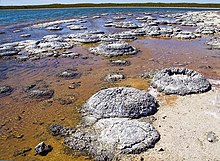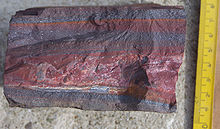Oxygen revolution
Main article: Great Oxygenation Event
See also: Ozone layer
Lithified stromatolites on the shores of Lake Thetis, Western Australia. Archean stromatolites are the first direct fossil traces of life on Earth.
A banded iron formation from the 3.15 Ga Moories Group, Barberton Greenstone Belt, South Africa. Red layers represent the times when oxygen was available; gray layers were formed in anoxic circumstances.
The earliest cells absorbed energy and food from the surrounding environment. They used fermentation, the breakdown of more complex compounds into less complex compounds with less energy, and used the energy so liberated to grow and reproduce. Fermentation can only occur in an anaerobic (oxygen-free) environment. The evolution of photosynthesis made it possible for cells to derive energy from the Sun.
Most of the life that covers the surface of the Earth depends directly or indirectly on photosynthesis. The most common form, oxygenic photosynthesis, turns carbon dioxide, water, and sunlight into food. It captures the energy of sunlight in energy-rich molecules such as ATP, which then provide the energy to make sugars. To supply the electrons in the circuit, hydrogen is stripped from water, leaving oxygen as a waste product.Some organisms, including purple bacteria and green sulfur bacteria, use an anoxygenic form of photosynthesis that uses alternatives to hydrogen stripped from water as electron donors; examples are hydrogen sulfide, sulfur and iron. Such extremophile organisms are restricted to otherwise inhospitable environments such as hot springs and hydrothermal vents.
The simpler anoxygenic form arose about 3.8 Ga, not long after the appearance of life. The timing of oxygenic photosynthesis is more controversial; it had certainly appeared by about 2.4 Ga, but some researchers put it back as far as 3.2 Ga.The latter "probably increased global productivity by at least two or three orders of magnitude". Among the oldest remnants of oxygen-producing lifeforms are fossil stromatolites.
At first, the released oxygen was bound up with limestone, iron, and other minerals. The oxidized iron appears as red layers in geological strata called banded iron formations that formed in abundance during the Siderian period (between 2500 Ma and 2300 Ma).When most of the exposed readily reacting minerals were oxidized, oxygen finally began to accumulate in the atmosphere. Though each cell only produced a minute amount of oxygen, the combined metabolism of many cells over a vast time transformed Earth's atmosphere to its current state. This was Earth's third atmosphere.
Some oxygen was stimulated by solar ultraviolet radiation to form ozone, which collected in a layer near the upper part of the atmosphere. The ozone layer absorbed, and still absorbs, a significant amount of the ultraviolet radiation that once had passed through the atmosphere. It allowed cells to colonize the surface of the ocean and eventually the land: without the ozone layer, ultraviolet radiation bombarding land and sea would have caused unsustainable levels of mutation in exposed cells.
Photosynthesis had another major impact. Oxygen was toxic; much life on Earth probably died out as its levels rose in what is known as the oxygen catastrophe. Resistant forms survived and thrived, and some developed the ability to use oxygen to increase their metabolism and obtain more energy from the same food.





Comments
Post a Comment